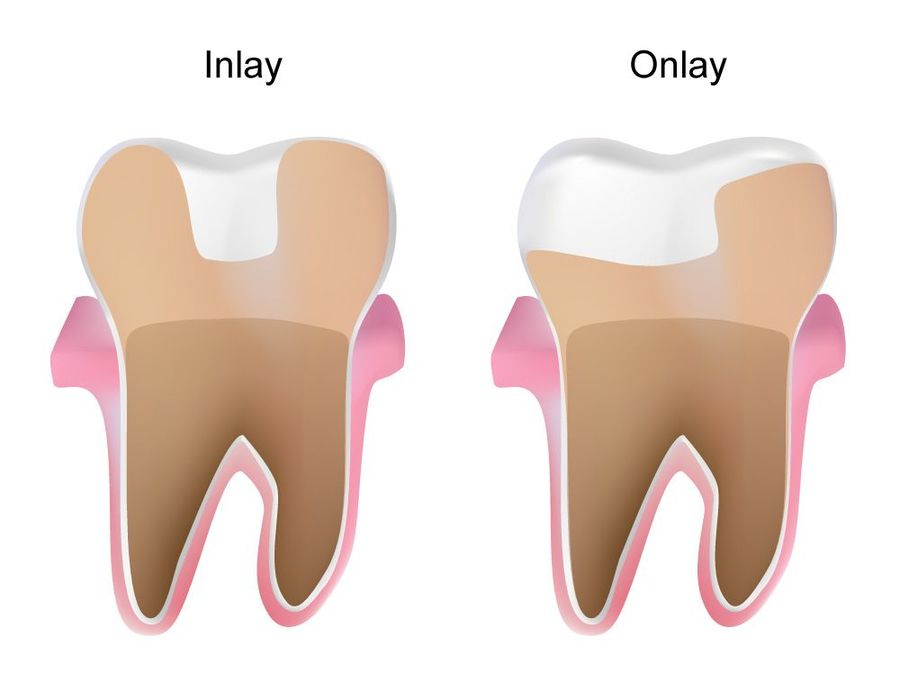Restorative dentistry
Restorative dentistry is the set of procedures that are needed when a piece of the patient’s tooth or the entire tooth is missing, or the tooth itself is in such a state that it can no longer be saved.
Dentures can be fixed or removable.
Fixed restorations are mostly crowns and bridges or dentures.
Premium quality tooth replacement - Dental crown
When is a dental crown necessary?
In case of extensive tooth decay or damage, the tooth may hurt and become discolored. This does not necessarily result in the loss of the tooth, our dentists can solve the tooth replacement by placing a crown in many cases. In order to preserve our perfect smile, the zirconium crown is the most elaborate and natural tooth replacement solution, regardless of whether we have a separate crown, bridge, or dental crown attached to an implant made.
What is the dental crown and what are its types?
A dental crown is a fixed dental prosthesis placed on a tooth stump above the gum line, possibly on a Premium Straumann, Nobel Active or Alpha Bio dental implant.
If the tooth itself is damaged to such extent that neither fillings nor inlays can be used during its treatment, the crown may be the ideal solution. In terms of material, the most common types are pressed ceramic crowns, porcelain crowns, and zirconium crowns.
Dental crowns are most often used when there is a large lack of dental material as a result of a broken tooth or neglected tooth decay.
The crown can also be placed for dental axis correction or for aesthetic reasons (crooked teeth, large gaps between individual teeth).
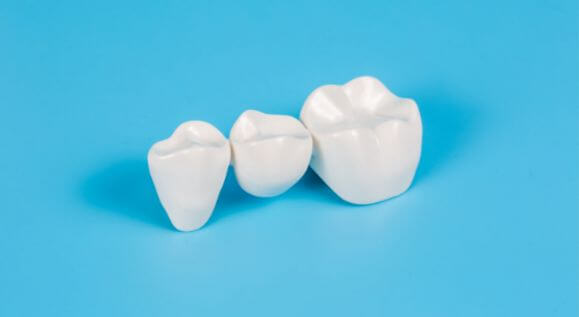
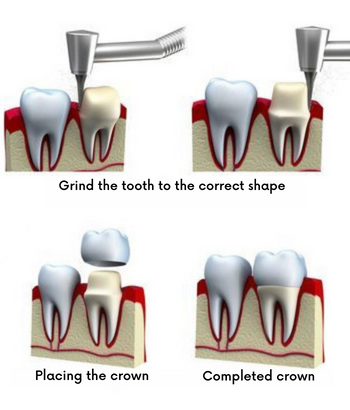
The steps of making a dental crown
- The dentist applies local anesthesia around the tooth holding the crown.
- The dentist then grinds the tooth to the correct shape.
- After the grinding, the dentist makes an impression of the surrounding dentition and the stump itself.
- A temporary plastic crown is placed on the tooth.
- After a few days, the final crown is ready, which the dental technician developed based on the impression made earlier.
- The dentist attaches the final crown to the polished tooth with special dental adhesive cement.
What types of dental crowns are available?
Zirconia crown
- translucent enough to have the appearance of a natural tooth
- does not contain metal
- long-lasting dentures: made of more durable and resistant material than other aesthetic solutions
- precision: the special CAD/CAM technology guarantees an excellent aesthetic effect and fit
Porcelain crown (Metal ceramic crown)
- strength: suitable choice for both incisors and chewing teeth
- durability: long-term, reliable tooth replacement
- natural appearance: tooth-colored outer surface
- accuracy: we guarantee an excellent aesthetic and fitting result with special computer-controlled CAD-CAM technology
Pressed ceramic crown
- It’s completely realistic
- It provides a perfect aesthetic appearance
- We guarantee an exact fit with special, computer-controlled CAD-CAM technology
- It does not contain metal, so it is an ideal solution for those with metal allergies
- Tissue friendly
What is a dental bridge and what is it for?
In dentistry, a bridge is suitable for replacing a missing tooth. Its most important purpose is to permanently replace missing teeth as a stiffened system.
The dental bridge, in terms of its structure, consists of dental crowns. The crown is only made for one tooth, while the dental bridge provides a complete solution for replacing several teeth.
There is also a bridge based on adjacent teeth and Premium Straumann, Nobel Active or Alpha Bio implants.
Features of a tooth-based bridge
With a tooth-based bridge, it is possible to place the bridge after the teeth surrounding the missing tooth have been properly designed. However, it is a condition that the surrounding teeth are completely intact and healthy. This is the only way our specialists can create such a condition that the bridge can fit correctly and stably on them.
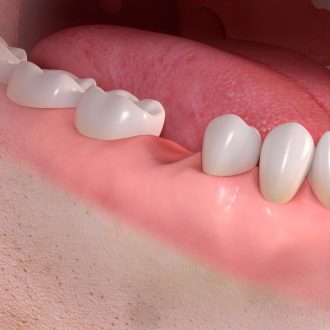
For a tooth-based bridge, the surface of the intact teeth supporting the bridge needs to be sanded down so that the fit is perfect.
Grinding itself does not endanger the healthy state of the teeth.
With this method, a tooth providing a perfect aesthetic experience will be created in a few weeks, faithfully reproducing the appearance of natural teeth.
However, it is worth being a little more careful when eating certain foods (harder bites).
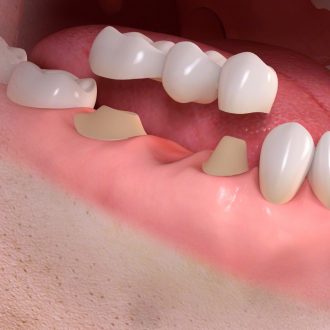
Features of the implant-based bridge
In the case of a bridge based on an implant, there is no need to grind down the healthy teeth surrounding the missing tooth, and thanks to the implant, it is also safer to chew harder bites. The load on the bone located in the area of deficiency will be uniform, without the risk of bone atrophy.
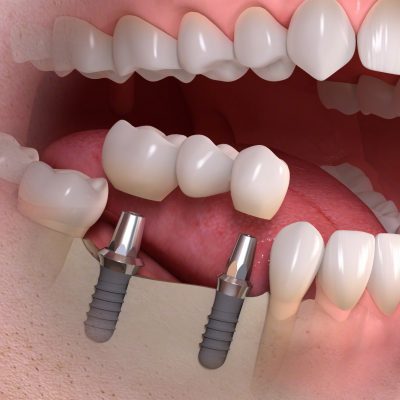
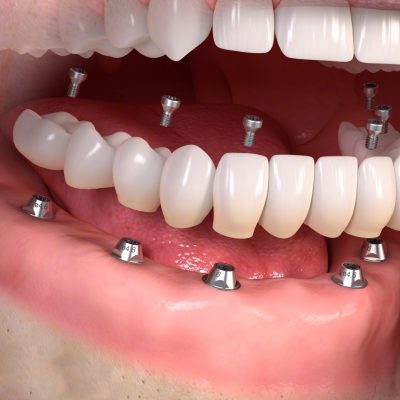
Fixed dentures
What is worth knowing about dentures?
Dentures are a tooth replacement method that provides an effective solution for patients who are missing a significant part of their teeth, or in some cases all of their teeth. The goal of dental prostheses is to completely restore the aesthetic and chewing function.
With fixed dentures, the full circular bridge or partial dental bridge is attached to the implants, so it is completely stable and does not need to be glued, which makes it more comfortable and does not fall out of the mouth. In addition, biting and chewing are more natural with it due to its stability. With fixed-removable dentures, implants ensure the stability of the denture, but the dentures are removable and thus easy to clean. In this dental replacement, a bridge (metal bridge) or locators (small metal balls) are placed on the implant, which snap into the place created for them in the prosthesis and hold the denture in place.
Fixed, removable dentures anchored to dental implants
A removable denture is a set of teeth anchored to a dental implant. This is a cheaper alternative compared to dental bridges fixed to the implant, and is also recommended in cases where it is not possible to replace each tooth individually with dental implants due to some health reason.
Fixed dentures are strongly and stably connected to the dental implant, which makes them much safer and more comfortable than non-fixed dentures. It is also smaller than a traditional prosthesis, which makes it much easier to wear and use in everyday life.
Why is dentures attached to dental implants recommended?
With a prosthesis attached to a Premium Straumann, Nobel Active or Alpha Bio implant, the original strength and quality of chewing can be restored, and denture adhesive is no longer necessary. In addition to supporting healthy digestion, it gives the wearer a natural appearance and will not have any problems with speech.
Fixed dentures do not irritate the gums, so they are much more comfortable to wear.
Premature aging of facial lines and loss of character can be prevented due to dental implants, as dental implants minimize bone loss. It follows from all of this that this is a long-lasting, stable dental replacement solution.
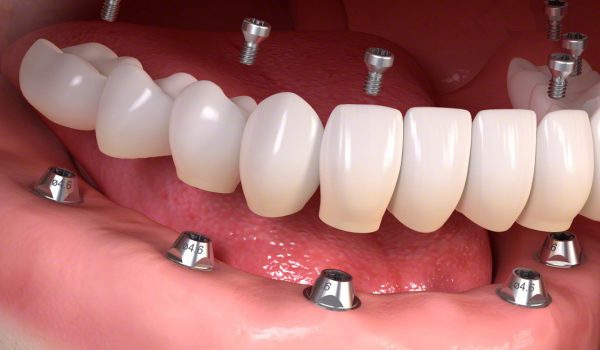
What types of fixed, removable dentures are there?
There are many tooth replacement methods, of which we can offer you the right solution at our clinic. Depending on the state of health, in the case of the lower jaw, even 2 dental implants may be enough to keep the denture. For the upper jaw, 4 or 6 artificial tooth roots are recommended.
The denture can be connected to the implants in several ways. One such method is the so-called jetty, which is a metal bridge, and the other is called a locator attachment. In the latter case, the dentist attaches small balls to the top of the implants, which snap into the place created for them in the prosthesis and hold the denture in place.
Bracket denture on 4 implants
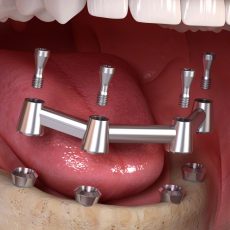
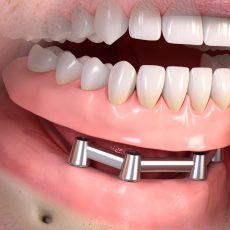
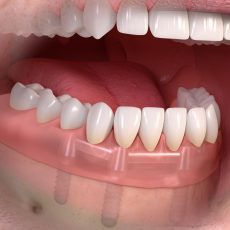
Sphere retention, removable dentures with locator on 2 or 4 implants
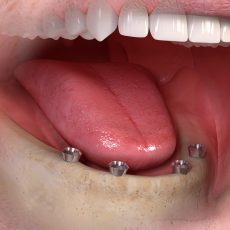
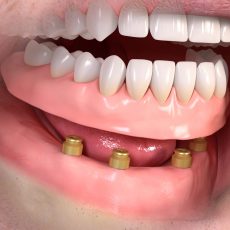
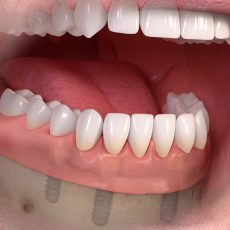
Dental replacement with dentures - treatment process
The process of placing dentures fixed on dental implants can be divided into two large parts.
- First stage
During the first steps of the treatment, the dentist extracts the teeth, if necessary, and then implants the dental implants. The healing time of the area around the implants is approx. 4-6 months, during which time the tooth roots integrate into the bone.
- Second stage
After the healing period, the so-called medical screws are placed, after which an impression is taken of the jaw bone and the bite height is adjusted. Then comes a test with the teeth placed in the wax, and finally the dental technician prepares the dentures based on all this, which the cosmetic dentist puts on and provides you with care for keeping your dentures intact and maintaining your oral hygiene.
Am I eligible to have fixed dentures?
All persons with good oral hygiene are considered suitable for this procedure. However, before starting this treatment, it is a good idea to assess the patient’s general health and daily habits.
The treatment requires an adequate amount and density of jaw bone stock, which can be checked with an X-ray, CT or Premium CBCT. Based on the diagnosis made in this way, the dentist can decide whether the bone is sufficient or whether a bone replacement is necessary.
However, there may be cases where dental implants are contraindicated, such as periodontitis, heavy smoking or teeth grinding. These should be avoided with appropriate treatment, and smoking should be stopped before and after the intervention.
What should I do, what should I pay attention to after placing the dentures?
Dentures attached to dental implants are basically designed so that they can be worn 24 hours a day, but these dentures must also be removed regularly for cleaning. Keeping the gums clean and healthy is very important for the stability and longevity of the implants.
That is why it is recommended to clean the dentures on a daily basis. During cleaning, wash the prosthesis and the surroundings of the implants, remove plaque from the superstructure placed on the dental implant with dental floss, use mouthwash and rinse your dentures.
Removable dentures
What is a denture and when is it recommended?
Dentures are an affordable tooth replacement method for our patients who are missing all their teeth. If you have your own teeth, but they are not in the right number and position, partial dentures are recommended.
The goal of both full and partial prostheses is to restore the chewing function and the aesthetic effect. Proper chewing is a basic condition for healthy digestion, in the absence of which digestive problems can occur, which can lead to further illness.
Aesthetics is part of our everyday life, without a confident appearance, our self-confidence can decrease significantly. However, a set of dentures made according to our abilities can restore our confidence and even make us look years younger.
Non-fixed, removable dentures
Non-fixed, removable dentures are a traditional solution to replace partial or complete missing teeth. In the case of both prostheses, the teeth are made of plastic. Porcelain teeth cannot be placed in the dentures, as they would pull the dentures out of place due to their weight.
Full plate dentures
Removable dentures must be attached to the gums with a special adhesive. This dental prosthesis is less stable, but it is easier to clean and the price is more favorable.
Non-fixed dentures are not very comfortable to wear, as they can move very easily, which can cause discomfort while eating and speaking. In addition, the phenomenon of atrophy of the jaw bone can also be experienced over time.
This is a consequence of the fact that there are no tooth roots in the bone, which stimulate the pressure of chewing into the bone, thus preventing bone loss. Over time, this bone loss can lead to changes in the shape of the face and displacement of the teeth.
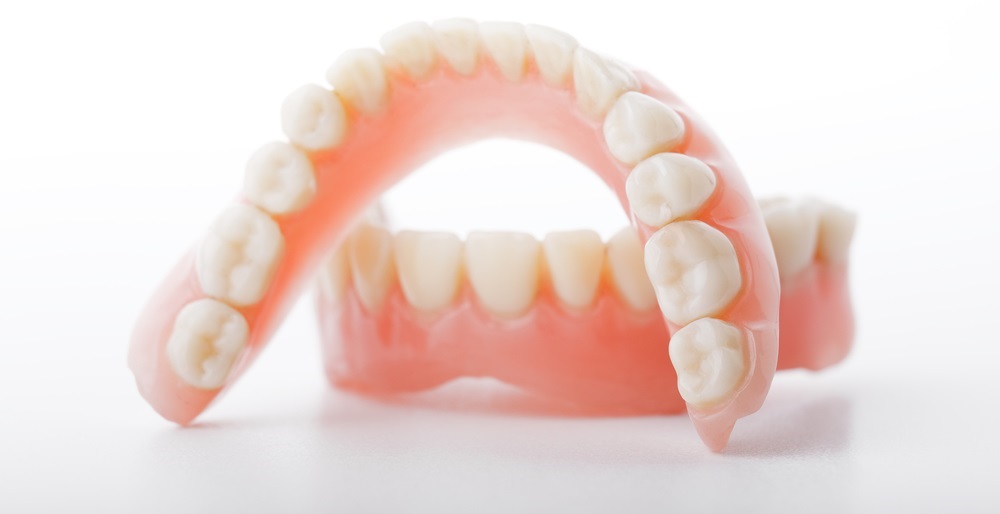
Types of partial plate dentures
In the case of partial dentures, the removable element can be connected to your intact teeth, crowns, and bridges in several ways:
- clip-on (clip-anchored)
- telescopic (anchored on the telescopic crown)
- fine mechanical (hidden anchorage)
The disadvantage of the metal clip is that it is not the best solution from an aesthetic point of view. Since in the case of hidden anchorage, the bridge and the removable denture are made together (combined work), it offers a much better aesthetic solution than the metal clasp, and the denture sits stably in the mouth.
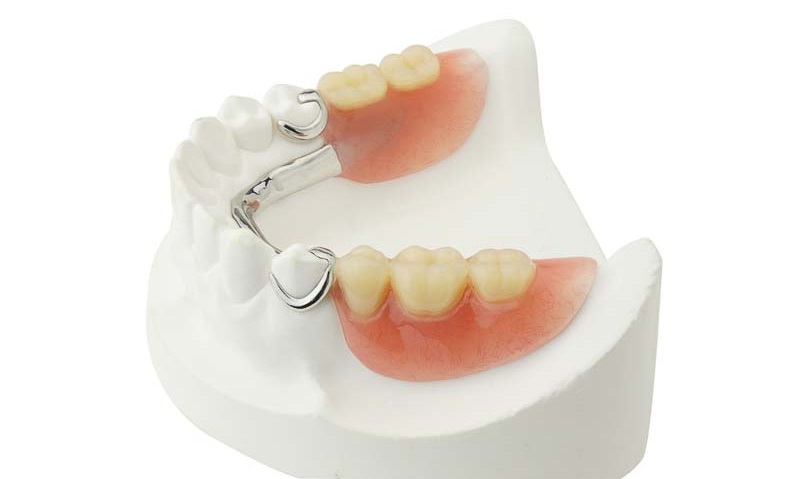
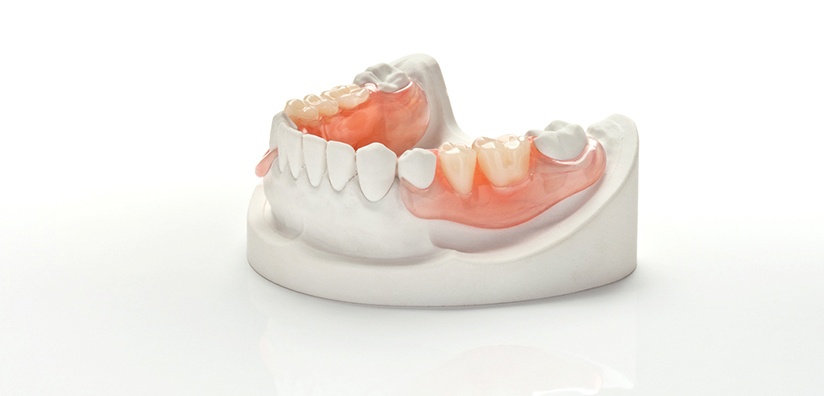
Dental inlays - Inlay, onlay
As a result of improper dental care or other physical or chemical effects, bacteria that are responsible for breaking down food can eventually multiply in the plaque that sticks to the teeth. However, the acids created in their wake begin to break down not only the food remains, but also the tooth tissue. This is how caries develop.
If the tooth decay is more advanced, a plain tooth filling will no longer be sufficient, as it does not have the necessary stability and strength.
In our dental clinic, our primary goal during our treatments is to preserve the teeth, so we also offer an aesthetic, natural-looking and long-lasting solution for larger cavities. Depending on the condition of the tooth, this solution can be an inlay or an onlay, which are simply called inlays.
In what cases is it recommended to use inlay or onlay?
Dental inlays should be used if the tooth decay affects a significant amount of the tooth, or if there is a risk that the decay may spread to neighboring teeth. It is customary to replace old, large amalgam fillings with inlays or onlays.
If the dentist considers that the chewing function and shape of the given tooth will not be suitable with the use of a plain dental filling, he may recommend gluing the insert. Inlay or onlay can also be an ideal solution for replacing broken or worn tooth tips, as a cover filling in the case of root canal treatment, and in the event that it is necessary to restore the bite height.
What are the advantages of dental inlays (inlay / onlay) for you?
Teeth can be permanently restored with the help of dental inlays. They have a high load capacity, are aesthetic and have great chewing stability. The tooth can be preserved by using an inlay or onlay, and it is not necessary to grind down the crown for the replacement. The inlays are made by taking an impression in a dental laboratory, so they are completely unique and adapted to the patient’s characteristics.
It is also very important to mention that the dental inserts do not contain any allergens, so they can be used safely by anyone.
What is inlay?
An inlay is a glued dental filling, a solid porcelain insert, which is individually prepared in a laboratory by a dental technician, and then glued in place. Inlay tooth filling is a technology used primarily for the construction of molars, when the tooth is broken or the decay is too great.
What is onlay?
An onlay is also an inlay, so it is very similar to an inlay. The difference lies in the fact that the onlay is used in the case of a larger hole, when the entire chewing surface must be covered, and the damage to the tooth is already too great for an inlay to be placed on that surface, because not only the chewing surface, but also the tips of the teeth damaged and requires care.
